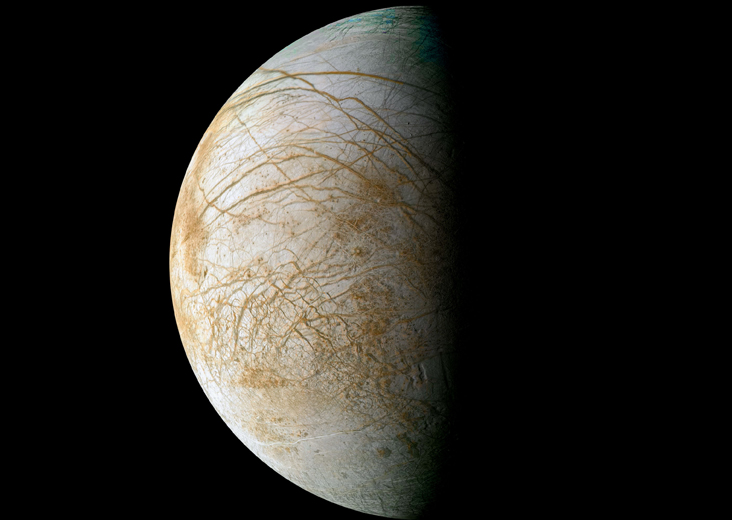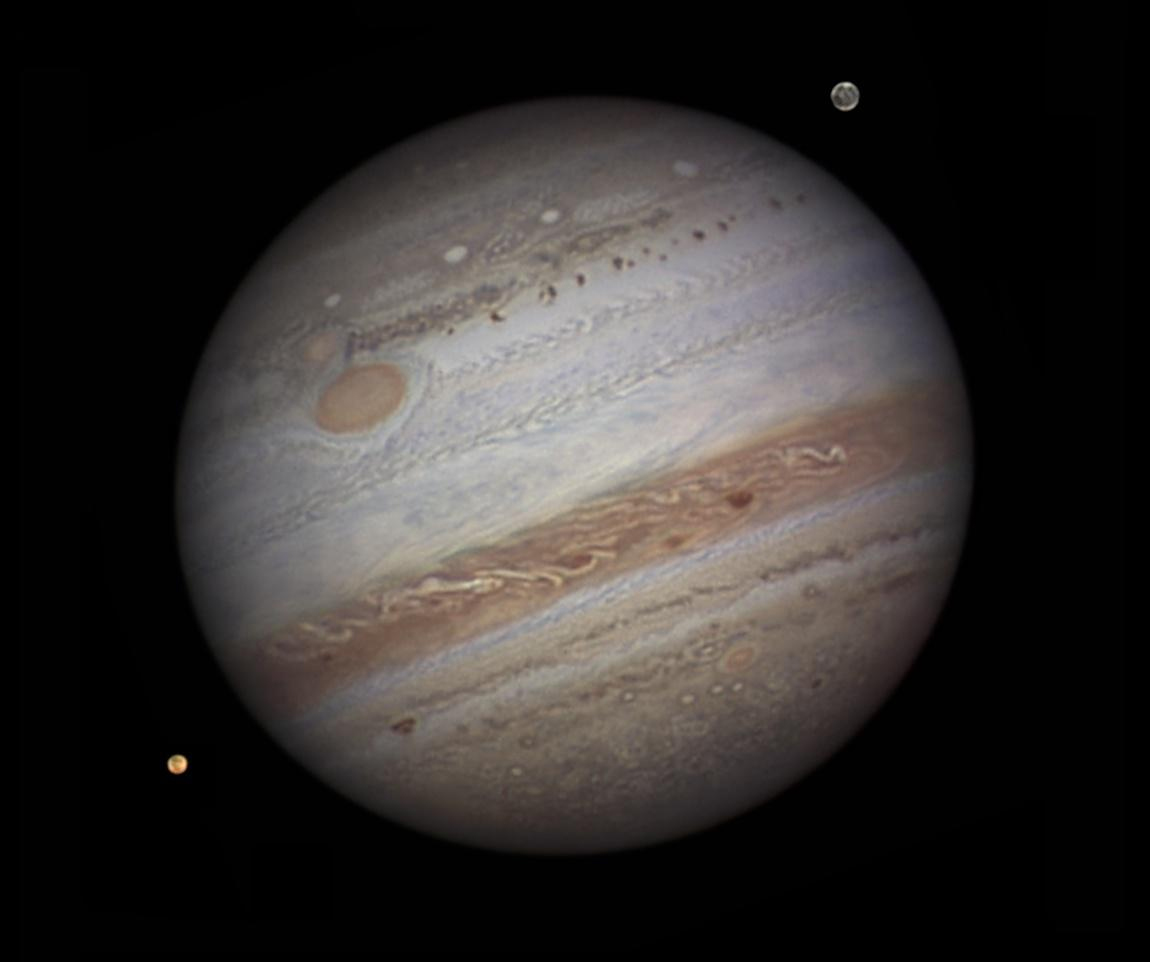How Jupiter Moon Europa's Underground Ocean Was Discovered

This is Part 4 of a six-part series telling the story of humankind’s efforts to understand the origins of life, by looking for it in extreme environments where life thrives without relying on the sun as an energy source.
It follows an oceanographic expedition to the Mid-Cayman Rise led by Chris German of the Woods Hole Oceanographic Institution, and NASA’s efforts to plan a future mission to Jupiter’s moon Europa. By understanding how life can live without the sun, we may discover how life began on our planet, and whether or not Earth is the only place in the universe capable of supporting a biosphere.
Nineteen seventy-seven was the kind of year that only comes around once every 176 years. That’s how often the outer planets of our solar system (Jupiter, Saturn, Uranus and Neptune — sorry, Pluto) line up just right in their orbits around the sun to allow for a spacecraft to slingshot past all four of them.
Rather than wait until 2153, NASA decided to take advantage of the opportunity of ‘77. The space agency launched the twin 1-ton space probe emissaries, Voyager 1 and Voyager 2, from Florida's Cape Canaveral in September and August of that year, respectively. [Voyager: Humanity's Farthest Journey (Video)]
The Voyager mission was only supposed to last for four years, and technically, both spacecraft were only heading to Jupiter and Saturn. Mission designers had planned Voyager 2’s trajectory so it could continue on toward Uranus and Neptune if Voyager 1 (which launched second but took a faster route) succeeded at Jupiter and Saturn. Fifty-two worlds and 12 years later, the Volkswagen Beetle-size probes brought new meaning to success in planetary science.
Their journeys to the outer planets gave humanity a front-row seat to see half the solar system up close in great detail for the first time (NASA's Pioneer 10 and 11 spacecraft had zipped past Jupiter in 1973 and 1974, but they were far less capable and yielded significantly less data).
The Voyager probes sent back stunning images of the Great Red Spot on Jupiter that revealed it to be a raging storm the size of two Earths. Saturn’s rings —thought to be smooth and ordered — were revealed to be oddly intertwining and kinked. The mission further discovered that Uranus orbits on its side and Neptune sports the fastest winds in the solar system.
Breaking space news, the latest updates on rocket launches, skywatching events and more!
And that was just the planets. The 48 moons captured by the Voyager craft were arguably even more striking than their parent planets.
Jupiter's Galilean moons
The largest of Jupiter’s satellites are the four Galilean moons — Io, Ganymede, Callisto, and Europa — which are named for their discoverer, Italian astronomer Galileo Galilee.
Galileo spotted them in 1610 after tweaking his telescope to reach a magnifying capability of 20x (20 times better than the naked eye). These four worlds were the first moons discovered orbiting a planet other than Earth. (Since our own moon is awfully hard to miss, we’ll never know who was the first person to look up and say, "What’s that?" Thus, it’s probably safe to credit Galileo with discovering moons.)
The Galilean moons proved to be full of surprises at close range. An active volcano was spotted on the innermost of the Galilean moons, Io, spouting ash and gases a whopping 174 miles (280 kilometers) in height — the first evidence of active volcanism beyond Earth.
The mission team would find half a dozen more erupting volcanoes on Io over the course of the mission. Team leader Brad Smith said this made Io look like a pizza. Later, astronomers would identify more than 400 active volcanoes there, making Io the most geologically active world in our solar system.
You’d think such a world might be a hot one, but you’d be wrong. Most of Io’s surface is minus 238 degrees Fahrenheit (minus 150 degrees Celsius). Colossal eruptions of gases condense and fall back to the surface as pastel yellow, orange and bluish-white sulfur dioxide snow.
This makes Io a surrealist’s dream: fiery hell plus winter wonderland with an everything-on-it sulfuric pizza surface and the churning clouds of Jupiter looming above hazy skies. [Amazing Photos: Jupiter's Volcanic Moon Io]
Tidal forces
Discovering Io’s volcanoes was like finding a smoking gun at a crime scene as far as astronomers were concerned — they disclosed a great deal of the moon's mysteries right off the bat.
The volcanoes determined Io’s swirling color palette — reds, yellows, browns, greens and gray-white sulfur dioxide frost. They also tipped scientists off to the phenomenon of tidal heating, which is the cause of Io’s agitation and the source of hope for testing Wächtershäuser’s hydrothermal vent theory beyond our home planet.
Volcanic activity on Earth is produced by a heat source that comes from energy released from the decay of radioactive materials deep inside the planet and also leftover heat from its formation.
But Io is too small for leftover heat and too active for its volcanoes to be explained by radioactive decay alone. Instead, the strong gravitational force from Jupiter pulls Io inward, while the weaker gravitational forces of its neighboring Galilean moons, Europa and Ganymede, pull Io outward.
These three moons actually fall into an elegant, stabilizing dance termed orbital resonance, where Io travels around Jupiter exactly twice as fast as Europa, which travels twice as fast as Ganymede. This makes the distance between Io and Jupiter vary along its orbit as the moon fights with the competing forces (or tidal forces).
These tremendous tidal forces alternate between squeezing and stretching the moon’s core, causing Io’s surface to rise and fall by the length of a football field every time it completes an orbit, which it does every 42.5 hours. Such squeezing and stretching cause friction. Friction causes heat and pressure. Heat and pressure cause molten material and gases to explode from the surface. Hence, volcanoes.
All eyes on Europa
Io’s smoking gun was pointing straight at its neighbor, the next closest Galilean moon to Jupiter: Europa. At the time of Voyager 1’s flyby of Io on March 5, 1979, scientists had just begun to re-think the internal makeup of the Galilean moons. If there was tidal heating on Io, partially caused by the gravitational forces of Europa and Ganymede, wouldn’t there be similar forces acting on Europa and Ganymede, too?
A month after the Io flyby, Voyager 1 came within several hundred thousand miles of Europa, though its trajectory was planned to take it back around Jupiter and away from the moon. Scientists had to wait another four months for Voyager 2 to get up close to Europa. [Photos: Europa, Mysterious Icy Moon of Jupiter]
By the time Voyager 2 reached Europa, the team’s hopes were soaring. They knew Europa was rich with water in its icy outer layer. If there was tidal heating on Europa, could it be substantial enough to melt the bottom of the moon’s ice crust, perhaps sustaining — gasp — a liquid water ocean?
Some even imagined they’d see several miles-long geysers bursting from the icy shell. But when the first photos came in, the team found no geysers. Instead, they were confronted with a giant white eyeball staring back at the camera, striped with wide brown veins slicing across the entire surface.
If you were to walk across that surface, Europa’s stripes would appear almost painted on. There’s almost no elevation change across most of the moon. Some scientists think the stripes may be cracks in the ice that spread pieces of the crust apart — not unlike seafloor spreading on Earth — allowing for liquid water to well up from the ocean beneath and freeze again, forming a younger swath of icy surface.
Despite the absence of geysers or volcanoes on its surface, Europa does experience strong tidal forces. On Earth, the tidal force from our moon controls the ocean tides, which influence when ships leave for a day of fishing or whether a sand castle on the beach will meet its demise an hour after its construction.
But on Europa, the effects of its host planet are a bit steeper. Jupiter is so much bigger than our moon — 30,000 times more massive — and so close to Europa that its tide stretches the 2,000-mile-wide (3,200 km) moon by more than 100 feet (30 meters).
This also makes the moon’s orbit ever-so-slightly non-circular, giving the orbit a tiny eccentricity, but one with enormous implications. Huge tidal forces are the crucial factors that suggest Europa’s ocean is able to remain in its liquid phase instead of freezing completely into the layer of ice above it. According to planetary scientists, everything interesting about Europa follows from this subtle eccentricity.
The evidence mounts
Further evidence for liquid water on Europa came from NASA's Galileo mission, launched in 1989, which brought far greater scientific firepower to bear on Jupiter and its moons. In particular, Galileo measured Europa’s magnetic field and found that it flips direction every five and a half hours — another byproduct of the domineering influence of its host planet. [Europa and Its Subsurface Ocean (Video)]
If an electrical conductor is placed in a varying magnetic field, electrical currents will be induced. Those currents will then induce a magnetic field oriented in the opposite direction to the original magnetic field that generated the current, partly canceling it out.
Since Jupiter has a powerful magnetic field and its axis of rotation doesn’t exactly line up with its magnetic axis, Europa crosses from the north side to the south side of Jupiter’s magnetic field — or vice versa — every 5 1/2 hours.
Imagine you are Jupiter and Europa is orbiting around your belt. Now, imagine trying to learn to hula-hoop for the first time. The wobbly hoop is the orbit of Jupiter’s magnetic field, and every time it touches your belt, it’s wobbling in a different direction. Up, down, up, down, up, down. This causes the orientation of the magnetic field in Europa’s orbit to vary as Jupiter rotates.
In Europa’s case, a magnetic field oriented in the opposite direction of Jupiter’s would indicate the moon has a massive electrical conductor somewhere inside it. And it just so happens that a moon-swallowing subsurface saltwater ocean matches the prediction for this electrical conductor quite nicely.
Along with its two compatriots Io and Ganymede, Europa dances a violent, synchronized tango around its host, causing friction and inducing a magnetic field — enough, many scientists say, to indicate the presence of a sloshing ocean somewhere beneath miles of occasionally shearing ice.
Below that potentially 100-mile-deep (160 km) ocean, there may be a seafloor that’s not so different from our own.
This story was provided by Astrobiology Magazine, a web-based publication sponsored by the NASA astrobiology program.


